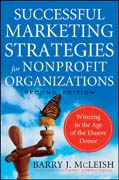
Successful marketing strategies for nonprofit organizations: winning in the age of the elusive donor
Mcleish, Barry J.
INDICE: Preface. Acknowledgments. Part One: Introduction. Chapter One: A New Way of Doing Business for the Nonprofit Organization. The Need for a New Marketing Orientation. Dealing with Nonprofit Organizations in Flux. Marketing tothe External World. Marketing Defined. Develop an Outline of Marketing Strategies. The Marketing Task. Marketing Tools. Use Distinctive Competencies to Assess the Competition. Summary. Chapter Two: The Development of a Marketing Strategy. Why a Marketing Strategy? First Steps in Defining Strategy. The Operating Environment's Effects on Marketing Strategy. First Steps to a Competitive Strategy. Breaking with Tradition to Remain Flexible. Summary. Chapter Three: The Phased Strategic Marketing Plan. External Analysis Phase. Internal Analysis Phase. Market Development Phase. Strategy Selection Phase. Presentation of thePlan. Summary. Part Two: The External Analysis. Chapter Four: External Analysis: Client, Donor, Volunteer, and Competitor Research. The Importance of Continuous Listening and Analysis: The Need to Uncover. Opportunities and Threats. Goals of Listening and Analysis. Building a Rational and Addressing Objectionsto Stakeholder Listening and Research. Other Research and Listening Concerns Including Flexibility. Start with Clients, Volunteers, Constituents, Customers, and Donors. Segmentation as the Next Step. Enduring and Dynamic SegmentationVariables. Describing Clients, Donors, Volunteers, Customers, and Constituents. Additional Segmentation Strategies Following an External Audit. External Analysis of Competitors. Positioning to Understand the Market. Ways to Identify Competition. How Nonprofit Organizations Compete. Summary. Chapter Five: Researching Your Nonprofit Organizations Environment. The Nature of a Nonprofit Organization's Environment. External Analysis, Competitors, and a Nonprofit's Environment. The Actual and Potential Size of the Competitive Environment. How Isthe Environment Structured? First, How Nonprofit Organizations Enter an Industry. Second, How Does the Nonprofit Organization Deliver Its Services? Third, What Is the Potential for Growth? Relating Product Life Cycles to Your Nonprofit's Growth Potential. Differentiating Your Nonprofit Based on External Analysis. Summary. Chapter Six: Competition and Internal Marketing Analysis. Reasonsfor an Internal Examination. Measuring Past and Current Performance. Dealing with Strategic Problems and Uncertainty. Assessing the Organizations Strengthsand Weaknesses. Looking for and Managing Long-Term Relationships. Cost and Performance Analysis Help Define Success. The Internal Audit Helps Define Organizational Strengths and Weaknesses. Summary. Chapter Seven: Value Propositions and Marketing Objectives. Developing Organizational Objectives. Using Objectives to Excel in Marketing. Marketing Performance Comes with Measuring Company Objectives. Staying Competitive. Chapter Eight: Creating Competitive Advantage.Strategy Options. Strategy of Hope. Investing in a Strategy While Not Counting the Cost. The Most Popular Strategic Orientations and the Implication to Your Organization. No Strategic Change. A Product and Cause Strategy. Matching the Market. Implications for Achieving Competitive Advantage. The Sustainable Competitive Advantage. What Comprises a Sustainable Competitive Advantage. Augmenting Success. Market Strategies. Chapter Nine: Winning through Competitive Strategy Options. The Nature of Strategy and Its Uses. Environmental Context andStrategic Options. Strategy Frameworks. Strategy Models. The Portfolio Framework. The Forces of Competition. Porter's Three Competitive Strategies. The Planning Process Framework. Summary. Chapter Ten: Creating a Competitive Image and Brand. Brand Formulation. Merging Brand and Strategy. Using the Brand Strategically. Reaching the Branded Goals of the Campaign. Summary. Epilogue. Notes.References. About the Author. Index.
- ISBN: 978-0-470-52981-2
- Editorial: John Wiley & Sons
- Encuadernacion: Cartoné
- Páginas: 288
- Fecha Publicación: 08/12/2010
- Nº Volúmenes: 1
- Idioma: Inglés
